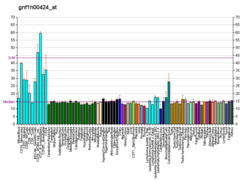WY 궁수태
WY Sagittae| 관측 데이터 Epoch J2000.0 이쿼녹스 J2000.0 | |
|---|---|
| 별자리 | 궁수자리 |
| 우측 상승 | 19h 32m 43.819s[1] |
| 탈위임 | 17° 44′ 55.86″[1] |
| 겉보기 크기 (V) | 5.4 - 20.7(파란색)[2] |
| 아스트로메트리 | |
| 거리 | 4200+400 −400[3] pc |
| 특성. | |
| 변수형 | 노바, 에클립싱 이진수 |
| 기타 지정 | |
| 데이터베이스 참조 | |
| 심바드 | 자료 |
WY Sagittae는 노바 Sagittae 1783으로도 알려져 있으며, 1783년에 노바 분화가 보이는 Sagitta 별자리에 있는 별이다.1783년 7월 26일 프랑스의 천문학자 조셉 레파우트 다이지레에 의해 발견되었다.수백 년 전에 발견된 노바에 대한 정확한 식별은 보통 어려운데, 그 위치는 종종 모호하게 보고되었기 때문이다(예를 들어 발견자는 노바가 발생한 별자리만 보고했을 수도 있다). 역사적으로 다른 종류의 과도 천문 사이에 뚜렷한 구분이 없었기 때문이다.노바에나 혜성 같은 [5]사건들그러나 D'Agelet은 이 노바를 벽화 사분면으로 관찰했는데, 이 사분면을 통해 현대 천문학자들이 이 별을 식별할 수 있을 정도로 정확한 좌표를 생성했다.[6]D'Agelet은 항성의 겉보기 크기를 6으로 보고했지만, D'Agelet의 기록을 분석한 Benjamin Apthorp Gould는 D'Agelet이 진도 6이라고 부르는 것이 현대의 규모 5.4 ± 0.4에 해당한다고 판단하여 노바가 육안으로 볼 수 있었다.[7]
WY Sagittae의 파괴 후 광선 곡선에 대해서는 거의 알려져 있지 않다.데이지렛은 1783년 7월 26일, 27일, 29일 각각 별의 크기를 6, 6, 6.7로 보고했다.적어도 6명의 관찰자들이 19세기 말과 20세기 초에 데이지렛의 노바를 찾으려고 시도했지만 성공하지 못했다.[6]1942년 윌슨산에서 60인치 망원경을 이용해 노바에 대한 사진 탐색이 실시되었고, 1950년 해롤드 위버는 사진 규모 18.9의 희미한 푸른 별을 대기 노바라고 잠정적으로 확인했다.이 별은 데이지렛이 보고한 위치에서 불과 몇 초밖에 떨어져 있지 않았고, 밝기의 변동은 정말로 노바라는 확신을 더해 주었다.[6]1971년 브라이언 워너는 오토 슈트루브 망원경으로 위버의 WY 사지태 후보를 관찰했고, 대기 노바에 어디서나 볼 수 있는 빠른 밝기 변화를 보았는데, 위버가 데이지렛 노바를 식별했음을 확인했다.[9]
모든 노바에 항성은 2진수 별이며, 백색 왜성을 공전하는 "도너" 항성이 있다.두 별은 서로 매우 가까워 물질이 기증된 별에서 백색 왜성으로 전달된다.별들 사이의 거리는 기증된 별의 반지름과 맞먹기 때문에, 노바에는 종종 은밀한 이진이 있고, WY Sagittae는 일식을 보여준다.상당히 깊은 일식(두 개의 크기)을 보면 이진의 궤도 주기가 3시간 41분임을 알 수 있다.[10][11]크리스티안 크니게는 기증자 별의 스펙트럼 타입을 M4±1로 분류했다.[12]Somers 외 연구진은 공여 항성의 스펙트럼 유형을 M3.5와 M4.5 사이, 백색 왜성의 질량은 0.5와 1.1 사이일 것으로 추정한다.M☉.[13]
외즈딘메즈 외 연구진은 WY Sagittae의 거리를 적신도를 기준으로 4200±400파섹으로 추정했다.[3]
WY Sagittae는 때때로 CK 벌페쿨레만이 나이가 더 든 채 두 번째로 오래된 "복원된" 노바(현대 관찰이 모호하게 nova 이후의 별을 식별한 역사적 노바를 의미한다)로 나열되기도 한다.[14]그러나 네일러 외 연구진은 CK 벌페쿨레는 노바가 아니며 WY Sagittae는 회수된 노바 중 가장 오래된 것이라고 주장한다.[15]
참조
- ^ a b Webbink, R.F.; Hazen, M.L.; Hoffleit, D. (July 2002). "Coordinates and Identifications of Harvard Variables". Information Bulletin on Variable Stars. 5298. Bibcode:2002IBVS.5298....1W.
- ^ Downes, Ronald; Webbink, Ronald F.; Shara, Michael M. (April 1997). "A Catalog and Atlas of Cataclysmic Variables-Second Edition". Publications of the Astronomical Society of the Pacific. 109: 345–440. Bibcode:1997PASP..109..345D. doi:10.1086/133900.
- ^ a b Özdönmez, Aykut; Güver, Tolga; Cabrera-Lavers, Antonio; Ak, Tansel (September 2016). "The distances of the Galactic novae". Monthly Notices of the Royal Astronomical Society. 461 (2): 1177–1201. Bibcode:2016MNRAS.461.1177O. doi:10.1093/mnras/stw1362. S2CID 118589678.
- ^ "WY Sge". SIMBAD. Centre de données astronomiques de Strasbourg. Retrieved 19 December 2020.
- ^ Hoffmann, Susanne M.; Vogt, Nikolaus (July 2020). "Counterparts of Far Eastern Guest Stars: Novae, supernovae, or something else?". Monthly Notices of the Royal Astronomical Society. 496 (4): 4488–4506. arXiv:2006.00977. Bibcode:2020MNRAS.496.4488H. doi:10.1093/mnras/staa1685. S2CID 219176617.
- ^ a b c Weaver, Harold F. (March 1951). "The Identification of D'agelet's Nova Sagittae of 1783". The Astrophysical Journal. 113: 320. Bibcode:1951ApJ...113..320W. doi:10.1086/145402.
- ^ Augustus Addison Gould; Benjamin Apthorp Gould; Benjamin Peirce; Hubert Anson Newton; William Holms Chambers Bartlett (1866). Reduction of the Observations of Fixed Stars Made by Joseph D'Agelet, at Paris, in 1783-1785: With a Catalogue of the Corresponding Mean Places, Referred to the Equinox of 1800.0. U.S. Government Printing Office. p. 237.
- ^ Somers, M. W.; Mukai, K.; Naylor, T. (February 1996). "Infrared photometry ofWY Sge:just an ordinary old nova?". Monthly Notices of the Royal Astronomical Society. 278 (3): 845–853. doi:10.1093/mnras/278.3.845. Retrieved 6 March 2022.
- ^ Warner, Brian (December 1971). "Photometry of WY SGE (Nova Sagittae 1783)". Publications of the Astronomical Society of the Pacific. 83 (496): 817. Bibcode:1971PASP...83..817W. doi:10.1086/129222.
- ^ Shara, M.M.; Moffat, A.F.J. (January 1983). "WY Sagittae (Nova 1783) : spectroscopic confirmations of Weaver's candidate and discovery of deep eclipses". The Astrophysical Journal. 264: 560–562. Bibcode:1983ApJ...264..560S. doi:10.1086/160624.
- ^ Shara, M.M.; Moffat, A.F.J.; McGraw, J.T.; Dearborn, D.S.; Bond, H.E.; Kemper, E.; Lamontagne, R. (July 1984). "WY Sagittae (nova 1783) : a transition object between classical and dwarf novae ?". The Astrophysical Journal. 282: 763–768. Bibcode:1984ApJ...282..763S. doi:10.1086/162260.
- ^ Knigge, Christian (December 2006). "The donor stars of cataclysmic variables". Monthly Notices of the Royal Astronomical Society. 373 (2): 484–502. Bibcode:2006MNRAS.373..484K. doi:10.1111/j.1365-2966.2006.11096.x. S2CID 2616606.
- ^ Somers, M.W.; Ringwald, F.A.; Naylor, T. (January 1997). "Spectroscopy of WY Sagittae (Nova 1783): detection of the irradiated secondary star". Monthly Notices of the Royal Astronomical Society. 284 (2): 359–364. Bibcode:1997MNRAS.284..359S. doi:10.1093/mnras/284.2.359.
- ^ Shara, Michael M. (January 1989). "Recent Progress in Understanding the Eruptions of Classical Novae". Publications of the Astronomical Society of the Pacific. 101: 5. Bibcode:1989PASP..101....5S. doi:10.1086/132400. hdl:2060/19900006554.
- ^ Naylor, T.; Charles, P.A.; Mukai, K.; Evans, A. (October 1992). "An observational case against nova hibernation". Monthly Notices of the Royal Astronomical Society. 258 (3): 449–456. Bibcode:1992MNRAS.258..449N. doi:10.1093/mnras/258.3.449.




